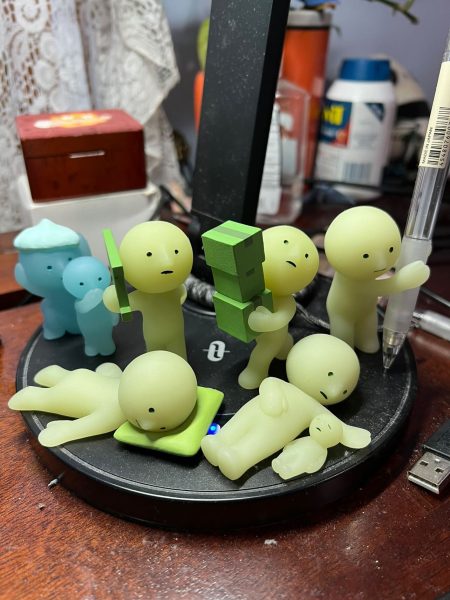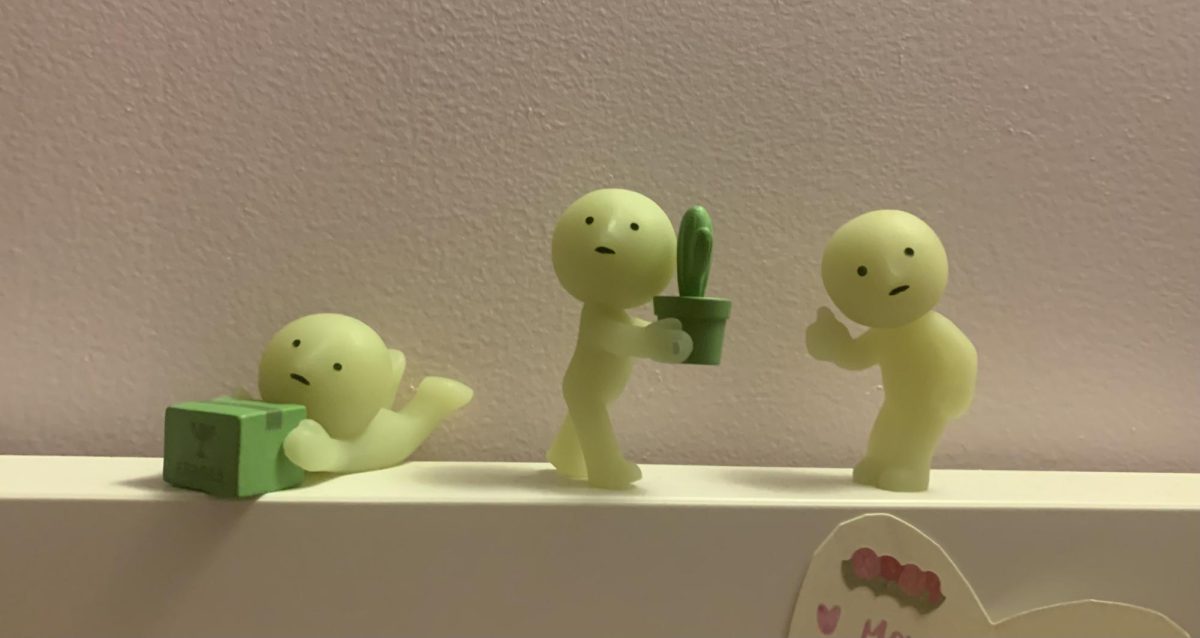There is one basket in one hand, and the other hand holds a tiny box with a green figure staring back at you. With its emotionless yet endearing face, a spherical head, and its stickbody-like figure, the Smiski are tiny little creatures inspired by Japanese mythology that are meant to keep people of various ages company.
What are Smiski?
Smiski are figurines that come in either green or blue. These figurines can be “charged” by sources of light (such as sunlight or simply LED ceiling lights) and glow in the dark. Smiski resemble stick figures, and although they all have the same neutral faces, they each have their unique, individual personalities.
Smiski are sold within mystery boxes, also known as blind boxes, a marketing strategy that allows the buyer to feel a sense of a ‘gambling thrill.’ Lucky buyers can also find that they purchased a box with a ‘secret Smiski,’ a bonus mini figurine.
Smiski also has different ‘series’, as most mystery boxes do. ‘Series’ refer to different themes that each box contains. For instance, there is the Smiski ‘Moving Series,’ as well as the Smiski ‘Museum Series.’ Smiski has a total of 20 series, along with other additional toothbrush holders and bath bomb surprises.
Smiski was created by the Japanese toy company Dream Inc. The Smiskis were pitched as an idea in Tokyo, Japan, with the creators’ hopes that they would bring joy and wonder into buyers’ hearts.

How to take care of Smiski!
Smiski are, surprisingly, a lot more delicate than they appear. Because of this, it is essential for buyers to preserve their Smiskis’ conditions in order to keep these creatures by their sides for longer periods of time.
First of all, it is important to make sure that the Smiski aren’t tossed around carelessly. This may lead to broken body limbs for the Smiski, which is, undoubtedly, unwanted.
Second, if your Smiski gets dusty, make sure to avoid water or any other cleaning solutions. Rather, use a soft cloth to get the dust off the figurine. Any other liquids may damage the Smiski’s outer coating, leading to the Smiskis being unable to glow in the dark properly.
Why are these creatures so appealing?
Undoubtedly, much of the Smiskis’ appeal stems from their mysteriousness.
These boxes will often have pictures of the potential figurines on the back of the box that the buyer could obtain. The grand reveal will allow the buyer to discover what figurine they purchased.
The main goal of buyers will be purchasing enough boxes in order to collect all the figurines shown on the back of the box. This will be referred to as a ‘series,’ which is a line of figurines that will follow a certain theme. Most companies that release mystery boxes will have multiple series in order to appeal to different buyers’ tastes and interests.
Additionally, within our brain, there is also a neurotransmitter that is referred to as dopamine.
When our bodies encounter a pleasant surprise (in this case, being the adorable Smiski figurines), the brain triggers a dopamine release, arousing feelings of pleasant and surprise.
Another reason why mystery boxes’ unpackaging is such a popular hobby is because it’s so easy! Even people who lack the time to invest into a tedious hobby can still get into collecting and buying blind boxes.
The concept itself is simple — all you have to do is purchase the mystery boxes in hopes of obtaining the one that you want!
But, as many others have pointed out, buyers can buy a variety of other products that involve these thrill-inducing, dopamine-releasing emotions. So what sets the Smiski apart?
According to Fiona Liu ’25, “The Smiski are so appealing because not only do they really capture my mood when I have to study for my exams – not to mention that I feel a lot better from the dopamine release I get when I even look at them!”
Where did it all begin?
Mystery boxes began with the Japanese fukubukuro, which were the first form of blind boxes ever seen.
In order to understand what the fukubukuro are, we should first understand the kanji, a form of Japanese written language that originated from Chinese characters to adapt into Japanese culture.
In Kanji, fuku means ‘good fortune,’ or ‘good luck,’ while fukuro means ‘bag.’ Once the two are combined, you would get the meaning of ‘good luck bag.’ However, because of the difficulty in pronouncing the double ‘f’ in fukufukuro, the ‘f’ was changed to a ‘b’– to fukubukuro!
There are two different historical origins to the fukubukuro – and they’re both incredibly unique.

One story says it started during the Edo period (1603-1867) at a kimono shop in Tokyo called Echigoya. They offered leftover fabric scraps in discounted bags, and the idea quickly caught on with other shops.
Another story claims the idea came from the Ginza Matsuya Department Store in the late Meiji era (around 1912).
The Ginza Matsuya Department Store sells a similar concept, in which the fukubukuro will contain unsold merchandise and be sold at lower prices. Some stores market the fukubukuro with positive connotations, and in some cases, fukubukuro will be sold on New Year’s – with the newest merchandise that rolled in. However, other stores will also play into the negative connotation of the fukubukuro, nicknaming them as “bad luck bags” or “garbage bags” and selling them at incredibly low prices.
Whichever story is true, fukubukuro is still a popular way for stores to clear out inventory and for shoppers to get surprise deals.
More familiar examples of mystery boxes are Kinder Eggs, theWonder Ball, LOL Surprise Dolls, Shopkins, and so many more diverse, nostalgic items.
Wang Ning, the founder of Popmart, claims that the trend of blind boxes began in Hong Kong in the 1990s. Popmart is yet another toy company that is known for its adorable figurines that come packaged in mystery boxes, similar to the Smiskis. Popmart is also a Beijing-based factory, and has sold Labubus (creatures with pastel-colored fur, rabbit ears, and monster teeth), Dimoos (aliens with cotton candy-shaped hair) and other cute figurines.

Who started the journey of Smiski?
Toru Soeya, the founder of Dreams Inc. is a Japanese businessman. Born in 1959, Soeya originally joined Bandai, a Japanese multinational toy manufacturer and distributor in 1992.
In 1996, however, he founded his own company: Dreams Inc. in Tokyo, Japan.
Then, in 2005, he released a successful product that is well known to this day – Sonny Angels.
Sonny Angels were meant to serve as a “pocket boyfriend” for single women around the age of 25 years old. Soeya had intended for the figurines to support women through their journeys of important decision making for their professional and personal lives.
This heartfelt message of supporting people of all ages and backgrounds became the company’s foundation.
The company’s corporate philosophy remains, “Like our corporate color, orange, our goal is to provide a brightly, energetic impression through our unique products. All our original products are planned and developed in-house. We are always looking for feedback from consumers worldwide and trying to create products that make your life happier. In our continuing effort to be loved by a wide group of people of all ages, we will keep offering colorful, happy products and ideas.”
And this is supported by students of Bronx Science as well! According to Kevin Si ’24, “Smiski figurines are great because they add an element of mystery and whimsy to any space. These small, adorable figures are full of personality and charm, making them perfect for collectors of all ages. Whether displayed on a shelf or hidden around the house for a delightful surprise, Smiski figurines bring joy and a touch of magic to everyday life.”
Smiski are figurines that come in either green or blue. These figurines can be “charged” by sources of light (such as sunlight or simply LED ceiling lights) and glow in the dark. Smiski resemble stick figures, and although they all have the same neutral faces, they each have their unique, individual personalities.

